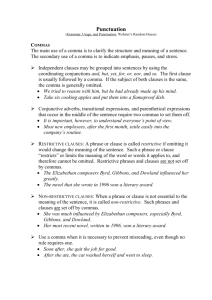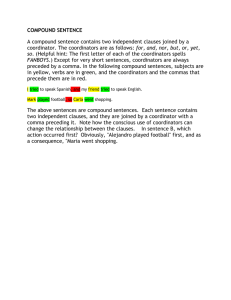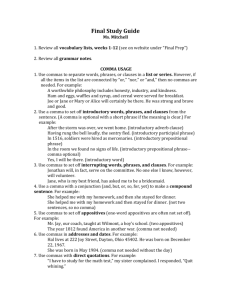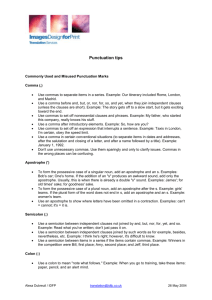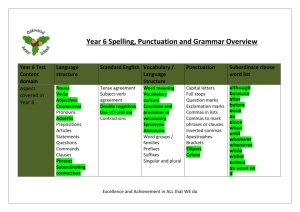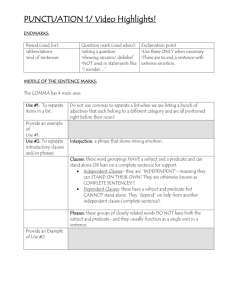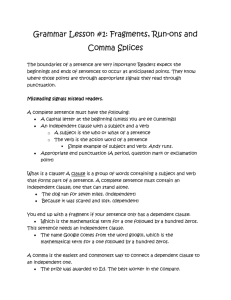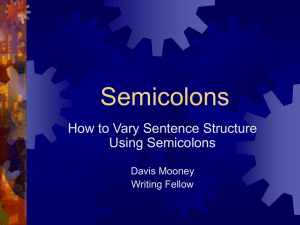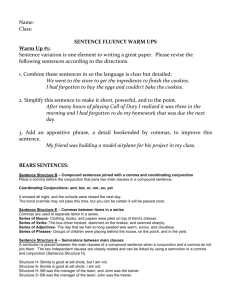Using Punctuation to Control Your Rhythm
advertisement
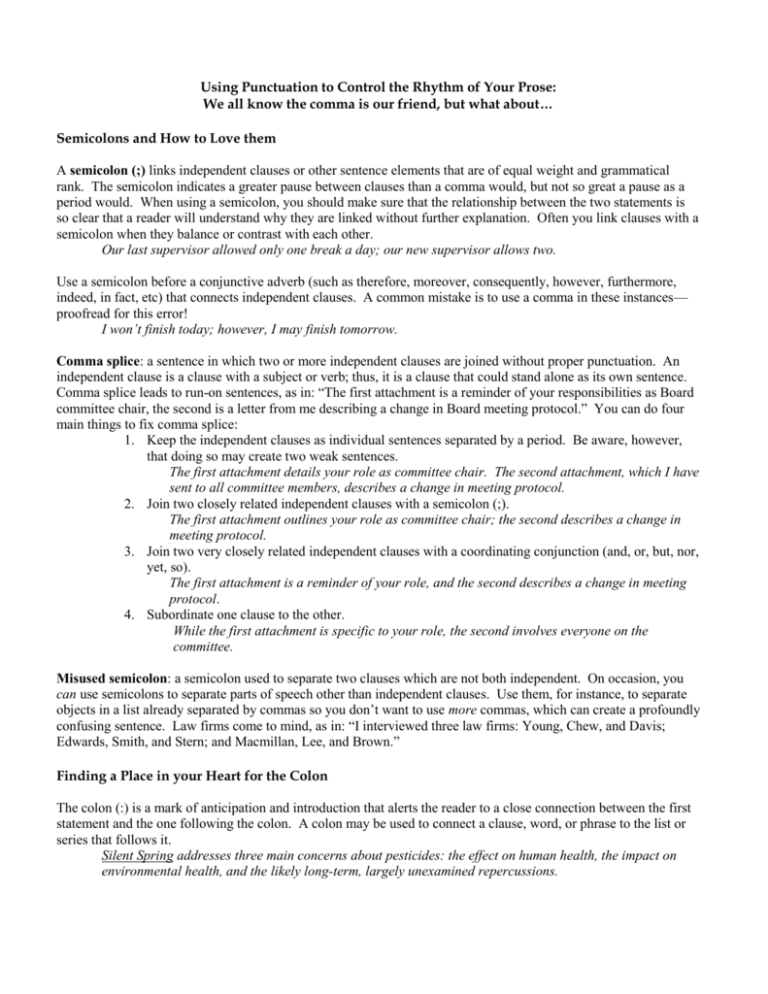
Using Punctuation to Control the Rhythm of Your Prose: We all know the comma is our friend, but what about… Semicolons and How to Love them A semicolon (;) links independent clauses or other sentence elements that are of equal weight and grammatical rank. The semicolon indicates a greater pause between clauses than a comma would, but not so great a pause as a period would. When using a semicolon, you should make sure that the relationship between the two statements is so clear that a reader will understand why they are linked without further explanation. Often you link clauses with a semicolon when they balance or contrast with each other. Our last supervisor allowed only one break a day; our new supervisor allows two. Use a semicolon before a conjunctive adverb (such as therefore, moreover, consequently, however, furthermore, indeed, in fact, etc) that connects independent clauses. A common mistake is to use a comma in these instances— proofread for this error! I won’t finish today; however, I may finish tomorrow. Comma splice: a sentence in which two or more independent clauses are joined without proper punctuation. An independent clause is a clause with a subject or verb; thus, it is a clause that could stand alone as its own sentence. Comma splice leads to run-on sentences, as in: “The first attachment is a reminder of your responsibilities as Board committee chair, the second is a letter from me describing a change in Board meeting protocol.” You can do four main things to fix comma splice: 1. Keep the independent clauses as individual sentences separated by a period. Be aware, however, that doing so may create two weak sentences. The first attachment details your role as committee chair. The second attachment, which I have sent to all committee members, describes a change in meeting protocol. 2. Join two closely related independent clauses with a semicolon (;). The first attachment outlines your role as committee chair; the second describes a change in meeting protocol. 3. Join two very closely related independent clauses with a coordinating conjunction (and, or, but, nor, yet, so). The first attachment is a reminder of your role, and the second describes a change in meeting protocol. 4. Subordinate one clause to the other. While the first attachment is specific to your role, the second involves everyone on the committee. Misused semicolon: a semicolon used to separate two clauses which are not both independent. On occasion, you can use semicolons to separate parts of speech other than independent clauses. Use them, for instance, to separate objects in a list already separated by commas so you don’t want to use more commas, which can create a profoundly confusing sentence. Law firms come to mind, as in: “I interviewed three law firms: Young, Chew, and Davis; Edwards, Smith, and Stern; and Macmillan, Lee, and Brown.” Finding a Place in your Heart for the Colon The colon (:) is a mark of anticipation and introduction that alerts the reader to a close connection between the first statement and the one following the colon. A colon may be used to connect a clause, word, or phrase to the list or series that follows it. Silent Spring addresses three main concerns about pesticides: the effect on human health, the impact on environmental health, and the likely long-term, largely unexamined repercussions. C. Smith Adv. Essay Writing Don’t use a colon between a verb and its object(s). Wrong: The three fluids for cleaning pipettes are: water, acetone, and alcohol. Right: The three fluids for cleaning pipettes are water, acetone, and alcohol. Similarly, don’t use a colon between a preposition and its object(s). Wrong: I would like to be transferred to: Boston, Miami, or New York. A colon may be used to link one statement to another that develops, explains, amplifies, or illustrates the first. A colon can be used this way to link two independent clauses. In such cases, you might choose to use a colon rather than a semicolon because the second clause defines or illustrates the first. In other words, a colon indicates that the second clause follows the first, rather than just showing a more generic close connection between the two clauses. Any large organization must confront two separate, though related, information problems: it must maintain an effective internal communication system, and it must maintaining an effective external communication system. Who Can Resist a Little M-Dash? The m-dash (—), not to be confused with the simple hyphen (-), is a versatile yet limited mark of punctuation. It is versatile because it can perform all the functions of punctuations: to link, separate, enclose, and show omission. It is limited because it is an especially forceful mark that tends to be easily overused. So use the m-dash cautiously, to indicate more informality, emphasis, or abruptness than other punctuation marks might show. Please note the correct way the m-dash should look, as modeled by the following sentences. Don’t put spaces before or after the mdash, and don’t try to substitute a hyphen for an m-dash. The m-dash can indicate a sharp turn in thought. That was the end of DDT—until the chemical companies found a loophole. The m-dash can indicate an emphatic pause. Consider the potential danger of a household item that contains mercury—a highly toxic substance. The m-dash can be used before a final summarizing statement or before repetition that has the effect of an afterthought or an emphatic restatement. The chemical companies put pressure on the press—a lot of pressure. M-dashes set off definitions with a great deal of emphasis, and therefore might be a good way to pause on, define, and underscore a key term. Carson calls for greater awareness of the interconnectedness of all life forms—a human-environmental bond fundamental to our very humanity—and insists that the government honor such a bond. M-dashes set off parenthetical elements more sharply and emphatically than do commas. Unlike m-dashes, parentheses tend to reduce the importance of what they enclose. Contrast the following sentences: Only one person—the president—can authorize such activity. Only one person, the president, can authorize such activity. Only one person (the president) can authorize such activity. Use m-dashes for clarity when commas appear within a parenthetical element to avoid having too many commas. From Alvar Núñez Cabeza de Vaca’s enlightening journey across what is now the southern US and Mexico—moving not only through physical space but also through the roles of conquistador, castaway, slave, and defender of Indian rights—to Rowlandson’s three months of unparalleled exposure to the New England wilderness, Indian captives gained unique insight into the Americas; however, how these experiences informed their visions of either native and European agendas has not been fully studied—until now. Page 2 C. Smith Adv. Essay Writing Pick and choose from the following phases and put punctuations between them for maximum effect. Try to use a range of commas, semicolons, colons, m-dashes, and periods. You should be able to keep this order, but you may eliminate phrases as you see fit. It was a dark and stormy night The wind howled The wolves howled The owls shrieked Tom and Alice huddled together in fear Hiding under the dining room table Draped in the blanket from the bed Neither knew what to expect And yet They knew something was about to happen Something bad Something very bad Suddenly the doorbell rang “Are you expecting someone?” asked Tom “No, are you?” retorted Alice Tom looked at Alice Alice looked at Tom “Go see who it is” urged Tom “You go see who it is” replied Alice Both fell quiet Sat unflinchingly still Not moving a muscle or even daring to breathe And then it happened From the other side of the door The voice A cracked and broken tenor Like you might hear in a middle school choir Called out “Hey did somebody order a pizza?” Page 3
